1. Eiffel Tower
Once the tallest structure in the world, the Eiffel
Tower is probably Europe's best known landmark and Paris's most famous
symbol.
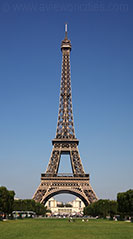
1889 World Exhibition
The Eiffel Tower was built for the World Exhibition
in 1889, held in celebration of the French Revolution
in 1789.
The construction was only meant to last for the duration of the Exposition, but it still stands today, despite all protests from contemporary artists who feared the construction would be the advent of structures without 'individuality' and despite the many people who feared that this huge 'object' would not fit into the architecture of Paris.
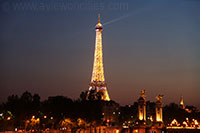 Today, there is no such aversion
anymore among the Parisians, and one could not imagine
Paris without the Eiffel Tower, in fact it has become
the symbol of the City of Light.
Today, there is no such aversion
anymore among the Parisians, and one could not imagine
Paris without the Eiffel Tower, in fact it has become
the symbol of the City of Light.
The construction was only meant to last for the duration of the Exposition, but it still stands today, despite all protests from contemporary artists who feared the construction would be the advent of structures without 'individuality' and despite the many people who feared that this huge 'object' would not fit into the architecture of Paris.

2. Notre Dame
Not the largest cathedral in the world, the
Notre-Dame might be the most famous of all cathedrals. The gothic
masterpiece is located on the Île de la Cité, a small island in the heart of the city.
A Religious site
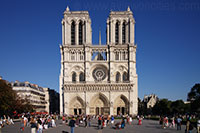
Notre Dame de Paris
The site of the Notre dame is the cradle of Paris
and has always been the religious center of the city. The Celts had
their sacred ground here, the Romans built a temple to worship Jupiter. A
Christian basilica was built in the 6th century and the last religious
structure before the Notre-Dame construction started was a Romanesque
church.
Construction
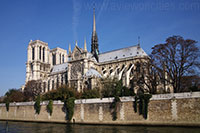
Bishop Maurice de Sully started the construction in
1163. The Cathedral was to be built in the new gothic style and had to
reflect Paris's status as the capital of the Kingdom France. It was the
first cathedral built on a monumental scale and became the prototype
for future cathedrals in France, like the cathedrals of Amiens, Chartres
or Rheims, just to name the most famous.
The Building
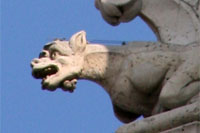
Gargoyle
It took until 1345 before the cathedral was
completed, partly because the design was enlarged during construction.
The result is an overwhelming building, 128m long (420 ft) with two 69
meter tall towers (226 ft). The spire, which reaches
90m (295 ft), was added in the 19th century by Viollet-le-Duc. The
Notre-Dame Cathedral has several large rose windows, the northern 13th
century window is the most impressive. The massive window has a diameter
of 13.1 meter.
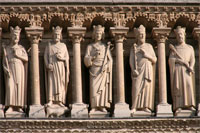 The frontal west facade features 3 wide portals; above the portals is
the Gallery of Kings - 28 statues of Judean Kings -
and higher up are the famous gargoyles and grotesques. The
spectacular eastern flying buttresses at the east side of the building
are 15m wide.
The frontal west facade features 3 wide portals; above the portals is
the Gallery of Kings - 28 statues of Judean Kings -
and higher up are the famous gargoyles and grotesques. The
spectacular eastern flying buttresses at the east side of the building
are 15m wide.

Gallery of Kings
Restoration
During the Revolution, many of the cathedral's
sculptures, gargoyles and interior was removed or demolished. Even the
gallery of Kings was severely damaged: the revolutionaries though the
statues represented
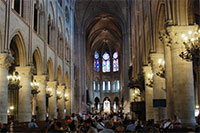 French Kings.
French Kings.
It wasn't until the 19th century before the Cathedral was fully restored thanks in part to the writer Victor Hugo, who with his book 'Notre-Dame de Paris', made the Parisians realise the cathedral was worth restoring. The 20 year long restoration was led by a local architect, Eugène Emmanuel Viollet-le-Duc. Viollet-le-Duc made drastic, controversial modifications to the building and even added a spire. The cathedral was restored again between 1991 and 2001, this time the historic architecture was carefully preserved.

Inside the cathedral
It wasn't until the 19th century before the Cathedral was fully restored thanks in part to the writer Victor Hugo, who with his book 'Notre-Dame de Paris', made the Parisians realise the cathedral was worth restoring. The 20 year long restoration was led by a local architect, Eugène Emmanuel Viollet-le-Duc. Viollet-le-Duc made drastic, controversial modifications to the building and even added a spire. The cathedral was restored again between 1991 and 2001, this time the historic architecture was carefully preserved.
3. Arc de Triomphe
In the middle of the Place Charles de Gaulle, at the border
of the 8th, 16th and 17th arrondissement stands one of the
greatest arches in history: the Arc de Triomphe (arch
of triumph).
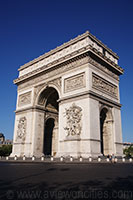
Arc de Triomphe
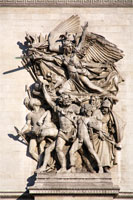
Marseillaise Relief
Napoleon's Triumphal Arch
The arch was commissioned by Napoleon in 1806 to commemorate
his victories, but he was ousted before the arch was
completed. In fact, it wasn't completed until 1836 during
the reign of Louis-Philippe. The Arc de Triomphe is
engraved with names of generals who commanded French
troops during Napoleon's regime.
Design
The design of the arch by Jean Chalgrin is based on the Arch of Titus
in Rome. The Arc de Triomphe
is much higher (50m versus 15m), but it has exactly
the same proportions.
The triumphal arch is adorned with many reliefs, most of them commemorating the emperor's battles. Among them are the battle of Aboukir, Napoleons victory over the Turkish and the Battle of Austerliz, where Napoleon defeated the Austrians.
The best known relief is the Departure of the Volunteers in 1792, also known as the Marseillaise. At the top of the arch are 30 shields, each of them bears the name of one of Napoleon's successful battles. Below the arch is the Grave of the Unknown Soldiers, honoring the many who died during the first World War.
The triumphal arch is adorned with many reliefs, most of them commemorating the emperor's battles. Among them are the battle of Aboukir, Napoleons victory over the Turkish and the Battle of Austerliz, where Napoleon defeated the Austrians.
The best known relief is the Departure of the Volunteers in 1792, also known as the Marseillaise. At the top of the arch are 30 shields, each of them bears the name of one of Napoleon's successful battles. Below the arch is the Grave of the Unknown Soldiers, honoring the many who died during the first World War.
Place Charles de Gaulle
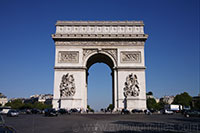
The arch is located at the end of the Champs-Elysées, in the middle of the Place Charles de Gaulle, a large circular square from which no less than 12 streets emanate. The streets
are named after French military leaders.
Observation deck
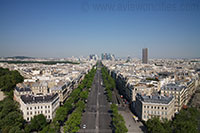
View from Arc de Triomphe
4. Louvre
Musée du Louvre
The Louvre, originally a royal palace but now the
world's most famous museum, is a must-visit for anyone with a slight
interest in art. Some of the museum's most celebrated works of art
include the Mona Lisa and the Venus of Milo.

The Louvre Museum is one of the largest and most important museums in
the world. It is housed in the expansive Louvre Palace, situated in the
1st arrondissement, at the heart of Paris.
Louvre Museum
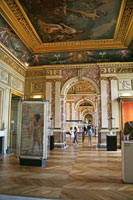
Louvre Interior
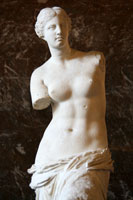
Venus of Milo
The collection of the Louvre Museum was first established in the 16th
century as the private collection of King Francis I. One of the works of
art he purchased was the now famous Mona Lisa painting. The collection
grew steadily thanks to donations and purchases by the kings. In 1793,
during the French Revolution, the Louvre became a national art museum
and the private royal collection opened to the public.
The museum has a collection of over 1 million works of art, of which about 35 000 are on display, spread out over three wings of the former palace. The museum has a diverse collection ranging from the Antiquity up to the mid 19th century.
Some of the most famous works of art in the museum are the Venus of Milo, the Nike of Samothrake, the Dying Slave by Michelangelo and of course Leonardo da Vinci's Mona Lisa.
After entering the museum through the Louvre Pyramid or via the Carrousel du Louvre, you have access to three large wings: Sully, Richelieu and Denon. Below a brief description of the highlights in each wing.
The museum has a collection of over 1 million works of art, of which about 35 000 are on display, spread out over three wings of the former palace. The museum has a diverse collection ranging from the Antiquity up to the mid 19th century.
Some of the most famous works of art in the museum are the Venus of Milo, the Nike of Samothrake, the Dying Slave by Michelangelo and of course Leonardo da Vinci's Mona Lisa.
After entering the museum through the Louvre Pyramid or via the Carrousel du Louvre, you have access to three large wings: Sully, Richelieu and Denon. Below a brief description of the highlights in each wing.
Sully Wing
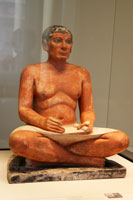
Seated Scribe
The Sully wing is the oldest part of the Louvre. The second floor
holds a collection of French paintings, drawings and prints. One of the
highlights is the erotic Turkish Bath, painted in the late 18th century
by Jean-Auguste-Dominique Ingres.
The first and ground floors of the Sully wing display works from the enormous collection of antiquities. In the 30 rooms with Egyptian antiquities you find artifacts and sculptures from Ancient Egypt such as the famous Seated Scribe and a colossal statue of Pharaoh Ramesses II. On the ground floor is the statue of Aphrodite, better known as the 'Venus of Milo', one of the highlights of the Louvre's Greek collection.
For something completely different, you can go to the Lower Ground Floor of the Sully wing where you can see some remnants of the medieval castle of the Louvre.
The first and ground floors of the Sully wing display works from the enormous collection of antiquities. In the 30 rooms with Egyptian antiquities you find artifacts and sculptures from Ancient Egypt such as the famous Seated Scribe and a colossal statue of Pharaoh Ramesses II. On the ground floor is the statue of Aphrodite, better known as the 'Venus of Milo', one of the highlights of the Louvre's Greek collection.
For something completely different, you can go to the Lower Ground Floor of the Sully wing where you can see some remnants of the medieval castle of the Louvre.
Richelieu Wing
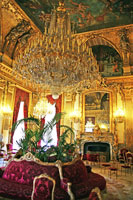
Napoleon III apartments
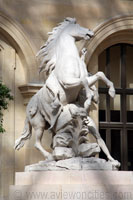
Marly Horse
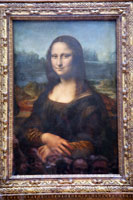
Mona Lisa
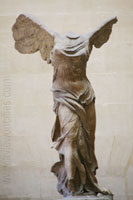
Winged Victory
Paintings from the Middle Ages up to the 19th century from across
Europe are on the second floor of the Richelieu wing, including many
works from master painters such as Rubens and Rembrandt. Some of the
most notable works are the Lacemaker from Jan Vermeer and the Virgin of
Chancellor Rolin, a 15th century work by the Flemish painter Jan van
Eyck. The first floor of the Richelieu wing houses a collection of
decorative arts, with objects such as clocks, furniture, china and
tapestries.
On the same floor are the sumptuously decorated Napoleon III Apartments. They give you an idea of what the Louvre interior looked like when it was still in use as a royal palace.
The ground and lower ground floor are home to the Louvre's extensive collection of sculptures. They are arranged around two glass covered courtyards: Cour Puget and Cour Marly. The latter houses the Horses of Marly, large marble sculptures created in the 18th century by Guillaume Coustou. Nearby is the Tomb of Philippe Pot, supported by eight Pleurants ('weepers').
The ground floor also houses a collection of antiquities from the Near East. The main attraction here is the Code of Hammurabi, a large basalt stele from the 18th century BC, inscribed with the Babylonian law code.
On the same floor are the sumptuously decorated Napoleon III Apartments. They give you an idea of what the Louvre interior looked like when it was still in use as a royal palace.
The ground and lower ground floor are home to the Louvre's extensive collection of sculptures. They are arranged around two glass covered courtyards: Cour Puget and Cour Marly. The latter houses the Horses of Marly, large marble sculptures created in the 18th century by Guillaume Coustou. Nearby is the Tomb of Philippe Pot, supported by eight Pleurants ('weepers').
The ground floor also houses a collection of antiquities from the Near East. The main attraction here is the Code of Hammurabi, a large basalt stele from the 18th century BC, inscribed with the Babylonian law code.
Denon Wing
The Denon Wing is the most crowded of the three wings of the Louvre
Museum; the Mona Lisa, a portrait of a woman by Leonardo da Vinci on the
first floor is the biggest crowd puller. There are other masterpieces
however, including the Wedding Feast at Cana from Veronese and the
Consecration of Emperor Napoleon I by Jacques Louis David. Another star
attraction of the museum is the Winged Victory of Samothrace, a Greek
marble statue displayed at a prominent spot in the atrium connecting the
Denon wing with the Sully wing.
The ground floor of the Denon wing houses the museum's large collection of Roman and Etruscan antiquities as well as a collection of sculptures from the Renaissance to the 19th century. Here you find Antonio Canova's marble statue of Psyche Revived by Cupid's Kiss. Even more famous is Michelangelo's Dying Slave. On the same floor are eight rooms with artifacts from Africa, Asia, Oceania and the Americas. Medieval sculptures from Europe are displayed on the lower ground floor of the Denon wing.
The ground floor of the Denon wing houses the museum's large collection of Roman and Etruscan antiquities as well as a collection of sculptures from the Renaissance to the 19th century. Here you find Antonio Canova's marble statue of Psyche Revived by Cupid's Kiss. Even more famous is Michelangelo's Dying Slave. On the same floor are eight rooms with artifacts from Africa, Asia, Oceania and the Americas. Medieval sculptures from Europe are displayed on the lower ground floor of the Denon wing.
History of the Louvre Palace
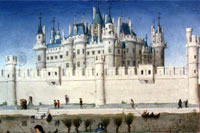
The Louvre in the 15th century
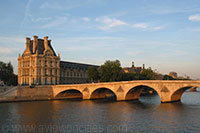
Louvre seen from across
the Seine
the Seine
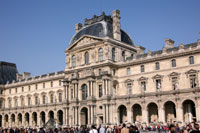
Richelieu Wing
The Louvre was created in several phases. Originally built as a 12th
century fortress by King Philip II, it was significantly expanded in the
14th century during the reign of King Charles V.
Its current palatial appearance goes back to the late 15th century, when the original fortress was demolished and the wing along the Seine river was built. The palace was extended during the 16th century by architect Pierre Lescot, who expanded the palace into a complex with two courtyards. A decade later Catharina de Medici added the Tuileries Palace to the west of the Louvre. Construction on the Louvre was halted for some time when king Louis XIV decided to move to the Versailles Palace.
In the 19th century, during the Second Empire, the Louvre was expanded again with the addition of the Richelieu wing. The wings were extended even further westward during the Third Empire. The Louvre now had four symmetric wings surrounding a large courtyard. This would not last long, as the Communards burned the Tuileries Palace to the ground in 1871, opening up the west side of the palace.
Its current palatial appearance goes back to the late 15th century, when the original fortress was demolished and the wing along the Seine river was built. The palace was extended during the 16th century by architect Pierre Lescot, who expanded the palace into a complex with two courtyards. A decade later Catharina de Medici added the Tuileries Palace to the west of the Louvre. Construction on the Louvre was halted for some time when king Louis XIV decided to move to the Versailles Palace.
In the 19th century, during the Second Empire, the Louvre was expanded again with the addition of the Richelieu wing. The wings were extended even further westward during the Third Empire. The Louvre now had four symmetric wings surrounding a large courtyard. This would not last long, as the Communards burned the Tuileries Palace to the ground in 1871, opening up the west side of the palace.
Louvre Pyramid
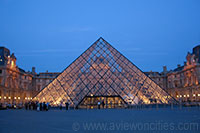
Louvre Pyramid
The most recent addition to the Louvre was the construction of the Louvre Pyramid,
which functions as the museum's main entrance. The pyramid was built in
1989 by the renowned American architect I.M. Pei. The glass pyramid
allows the sunlight to enter the underground floor.
The modern addition originally received mixed reviews, as it contrasts sharply with the classical design of the surrounding buildings, but today it is generally accepted as a clever solution which has given the museum a spacious central entrance without the need to touch the historic patrimony.
The modern addition originally received mixed reviews, as it contrasts sharply with the classical design of the surrounding buildings, but today it is generally accepted as a clever solution which has given the museum a spacious central entrance without the need to touch the historic patrimony.
4. Sacré-Coeur
Basilica of the Sacred Heart
The Sacré-Coeur Basilica is one of Paris's major tourist draws. The majestic
building is located on top of the Montmartre hill.
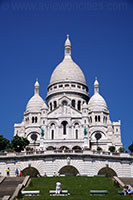
Sacré-Coeur
Montmartre
Above all, Montmartre, an area on a hill in the 18th arrondissement,
north of downtown Paris, is known for its many artists who have been
omnipresent since 1880. The name Montmartre is said to be derived from
either Mount of Martyrs or from Mount of Mars. Until 1873, when the
Sacré-Coeur was built on top of the hill, Montmartre was a small village, inhabited by a mostly farming community.
The Basilica Project
The project to build the Sacré-Coeur Basilica
(Basilica of the Sacred Heart) was initiated by a group of influential
people. Their reasons to build this monument was two-fold:
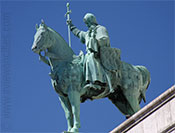 they had pledged to build a church if Paris escaped unscathed from the
war with the Prussians and they saw the defeat of the French at the
hands of the Prussian army in 1870 as a moral condemnation of the sins
of Paris.
they had pledged to build a church if Paris escaped unscathed from the
war with the Prussians and they saw the defeat of the French at the
hands of the Prussian army in 1870 as a moral condemnation of the sins
of Paris.
The project was authorized by the National Assembly in 1873, and a competition was organized. The goal was to build an imposing basilica true to Christian traditions.

King Louis IX
The project was authorized by the National Assembly in 1873, and a competition was organized. The goal was to build an imposing basilica true to Christian traditions.
The Building
The winner of the competition was Paul Abadie, who had already
restored two cathedrals in France. He designed an immense basilica in a
Roman-Byzantyne style. This architectural style stands in sharp contrast
with other contemporary buildings in France,
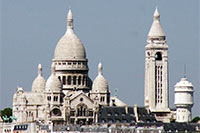 which were mostly built in a Romanesque style.
which were mostly built in a Romanesque style.
Construction of the Basilica started in 1876 with Abadie as the lead architect. When Paul Abadie died in 1884, he was succeeded by Lucien Magne, who added an 83 meter (272 ft) tall clock tower. The Savoyarde clock installed here is one of the world's largest.
Due to its location on the Montmartre hill, the basilica towers over the city; its highest point is even higher than the top of the Eiffel Tower. Thanks to this prominent location the Sacré-Coeur Basilica is one of the most
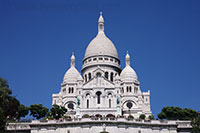 noticeable landmarks in Paris.
noticeable landmarks in Paris.

View from the
Parc des Buttes-Chaumont
Parc des Buttes-Chaumont
Construction of the Basilica started in 1876 with Abadie as the lead architect. When Paul Abadie died in 1884, he was succeeded by Lucien Magne, who added an 83 meter (272 ft) tall clock tower. The Savoyarde clock installed here is one of the world's largest.
Due to its location on the Montmartre hill, the basilica towers over the city; its highest point is even higher than the top of the Eiffel Tower. Thanks to this prominent location the Sacré-Coeur Basilica is one of the most

White Stones
The Sacré-Coeur Basilica has managed to keep its beaming white color
even in the polluted air of a big city like Paris. This can be
attributed to the Château-Landon stones which were used for the
construction of the Sacré-Coeur. When it rains, the stones react to the
water and secrete calcite, which acts like a bleache 


0 comments:
Post a Comment